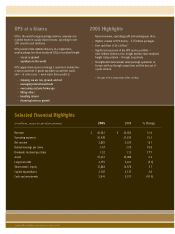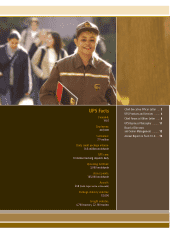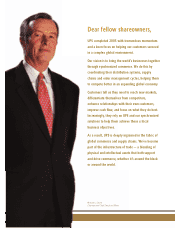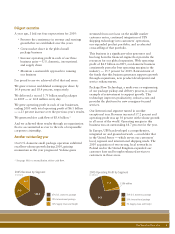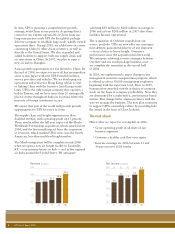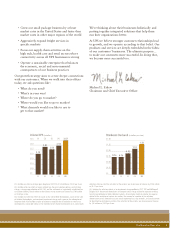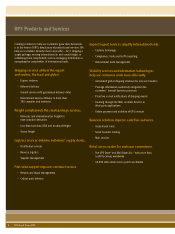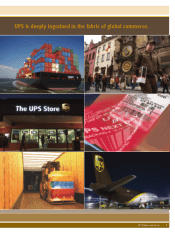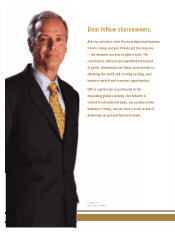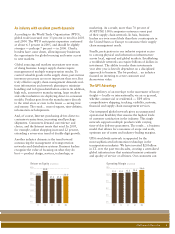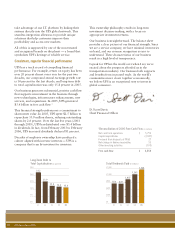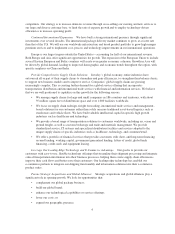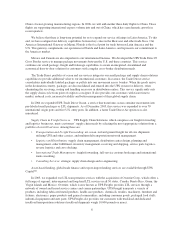UPS 2005 Annual Report Download - page 11
Download and view the complete annual report
Please find page 11 of the 2005 UPS annual report below. You can navigate through the pages in the report by either clicking on the pages listed below, or by using the keyword search tool below to find specific information within the annual report.
UPS Annual Report 2005
An industry with excellent growth dynamics
According to the World Trade Organization (WTO),
global trade increased over 13 percent in total for 2003
and 2004. The WTO anticipates expansion continued
at about 6.5 percent in 2005, and should be slightly
stronger — perhaps 7 percent — in 2006. Clearly,
borders have come down, allowing many businesses
the opportunity for global sourcing and easier access
to new markets.
Global sourcing and markets necessitate new ways
of doing business. Longer supply chains require
management of multiple transportation modes. To
control valuable goods in the supply chain, just-in-time
inventory processes are more important than ever. But
truly effective supply chain management demands real-
time information and network planning to minimize
handling and to bypass distribution centers. In addition,
high tech, automotive manufacturing, large retailers
and other industries are deploying direct-to-consumer
models. Product goes from the manufacturer directly
to the retail store or even to the home — saving time
and money. The result… more frequent, time-defi nite,
information-rich shipments.
And, of course, Internet purchasing drives direct-to-
consumer transactions, increasing small package
shipments. Consumers demand convenience and
choice, and the Internet meets that need. In 2005,
for example, online shopping increased 22 percent,
extending a seven-year trend of double-digit growth.
Another industry dynamic is the trend toward
outsourcing the management of transportation
networks and distribution systems. Business leaders
recognize the value of focusing on what they do
best — product design, services, technology, or
marketing. As a result, more than 70 percent of
FORTUNE 1000 companies outsource some part
of their supply chain network. In Asia, business
leaders are even more likely than their counterparts in
the United States or Europe to outsource their supply
chain management needs.
Finally, participation in our industry requires access
to a strong physical and information infrastructure
across local, regional and global markets. Establishing
a worldwide network can require billions of dollars in
investment. The ability to make these investments
year after year is heavily dependent on a disciplined
approach to business. The by-product… an industry
focused on investing to create customer and
shareowner value.
The UPS Advantage
From delivery of an envelope to the movement of heavy
freight — locally or internationally, via air or ground,
whether commercial or residential — UPS offers
comprehensive shipping, tracking, visibility, customs,
fi nancial and supply chain management services.
Our integrated global network gives us unsurpassed
operational fl exibility that ensures the highest levels
of customer satisfaction in the industry. This single
network supports multiple products with varying
time-of-day delivery guarantees. The result… a business
model that allows for economies of scope and scale,
optimum use of assets and industry-leading margins.
UPS’s worldwide network is supported by the
most sophisticated information technology in the
transportation industry. We have invested $20 billion
in I.T. over the past two decades, creating a centralized
global infrastructure that sustains business continuity
and quality of service at all times. Our customers can
%
(
+
.
&'
&*
%*
%)%(%'
%&
DeZgVi^c\BVg\^c^ceZgXZci
&(#&
&)#)
&(#+
&(#(
&(#&
%
*
&%
&*
'%
'*
(%
%*
%)%(%'%&
GZijgcdc:fj^in^ceZgXZci
')#% '(#(
'&#(
'&#'
'-#%
Chief Financial Offi cer Letter 9


